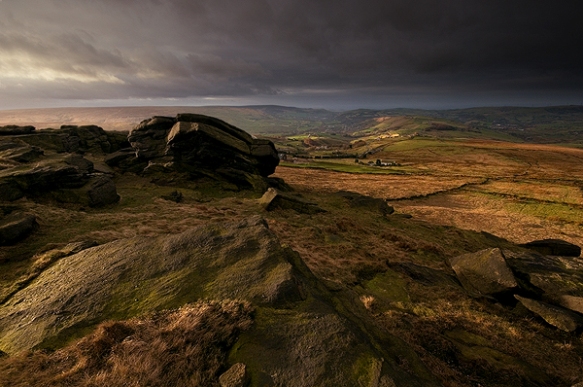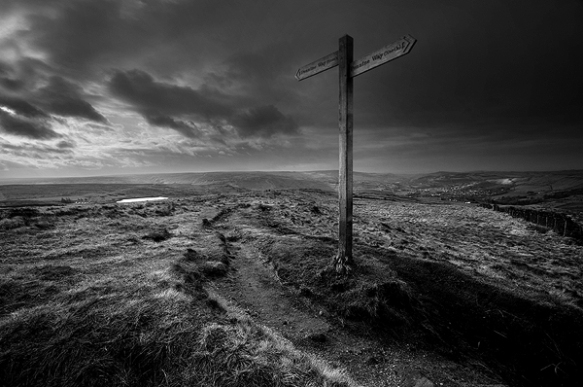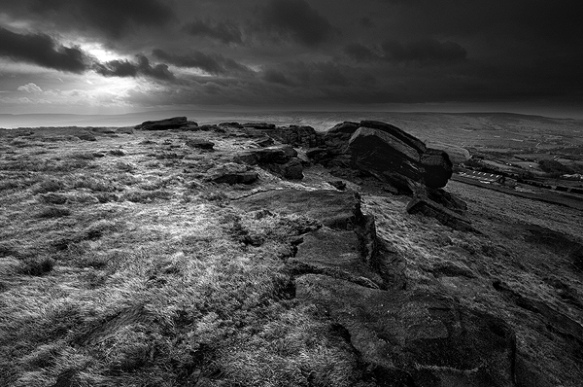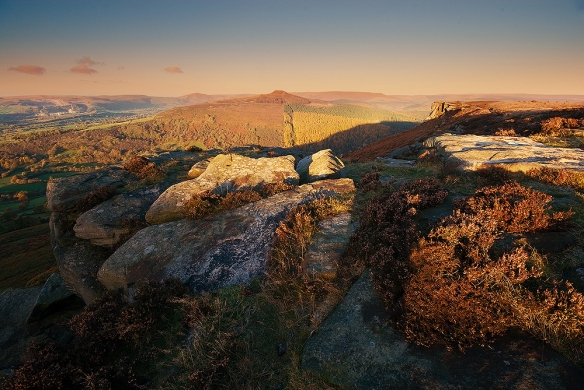What is it about landscape photography that makes me keep going back for more?
I spent much of one Sunday morning asking myself this question, as a ferocious wind did its damnedest to blast me off of Marsden Moor.

A wind blasted morning at Millstone Edge
Crouched behind a large rock, which provided at least a little shelter from the grasping fingers of the Pennine wind, waiting for a break in the clouds, I began to ponder just what it was that had coaxed me out of bed at 4.00am and up on to the moor on a day like this. I spotted a jogger approaching, the only other living soul that I saw all morning. We waved at each other in grim solidarity, in recognition of each other’s battle with the elements.
It was this that made me realise that it was a question of motivation. I could have been happily snoozing in a warm bed, but it was the promise of possibilities that had lured me up to the moor. The prospect of capturing something unique and beautiful, that told a little of the story of this amazing and often overlooked corner of the British Isles.
In my mind, landscape photography is about much more than taking photographs. It isn’t about the amount of kit that you carry with you. All of the stuff that you read in photography magazines is about making you buy more products from their advertisers, not about making you a better photographer.
To me, landscape photography is about getting to know your locations inside out. Appreciating how geology has formed the shape of the land, how human interaction has affected its appearance and the values that have been placed upon it. Going back time after time, experiencing locations in all seasons and weather conditions. After a while, you learn to read the landscape before you. Knowing where the sun will rise and set at any given time of year and which angles you can effectively photograph. How history has interacted with the landscape, building up layers of meaning and telling the story of the location.

Muddy moorland tracks

Hidden beauty! It is surprising what beauty can be found in a bit of boggy moorland
I have already written about the history of Marsden Moor here and here. Also about the area’s greatest son, Ammon Wrigley here. As you walk (or on this occasion, stagger) across the moor, you are surrounded by history. Every hilltop around you has something on it. Fragments of flint left by Mesolithic hunters, or burials left by Bronze Age farmers. Down in the valley of Castleshaw, the Romans built two forts, driving their road northwards over the moor and around Pule Hill. Angles, Saxons and Vikings made their farmsteads in the area (one Viking losing a gold ring in Chew Valley, over the hill in Saddleworth). The Normans used much of the area around Huddersfield for hunting, building their castle at Castle Hill nearby.
The industrial revolution swept through the area, bringing textile manufacture and sowing the seeds of the early Labour Movement throughout the valleys, in the shape of Luddites, Plug Rioters and Chartists. History even passes under your feet here, in the shape of the Standedge Tunnels. Redbrook engine house was used to haul rock out of the tunnel and you can still even see the rows in which the rock was tipped from carts on the spoil heaps surrounding the building. As the narrowest point of the Pennines, Standedge has for millennia, been the place where transport routes cross the hills.
The drystone wall outlines of fields wrestled from the moor, now lie jumbled, as the moor once again takes back its own. The Pennine Way crosses the moor. A symbol of hard won victories by our forefathers (in this case particularly Tom Stephenson) in wrestling access to the land from the ownership of the privileged few, for the enjoyment of the many. A battle fought famously on Kinder Scout, just a couple of hilltops away from here.

- A small section of the Pennine Way, as it crosses Marsden Moor

- Light breaking around the Pennine Way on Marsden Moor
I feel a deep connection with the Southern Pennines, particularly the areas around Huddersfield where I was born and where my father took me walking when I was as a child. The sense of wonder at the contrasts between the industrialised valleys, with dark mills and grim looking factories, clustering around the rivers and canals, and the wild hilltops has never left me. Once I left school and began work in those foreboding places, where daylight hardly penetrated through over a century of accumulated grime, those wild and airy hilltops became even more important as a means of escape. A liminal place to dream of better things. Maybe this is one of the reasons why the Chartists took their meetings on to the hills. Not just to evade the watchful eye of authority, but to take their ideas to a place where freedom is tangible and ideas are received by the expansive sky, rather than the stamping boot of oppression.
Most of those factories are now gone. Nowhere is this more apparent than in Milnsbridge, which once bristled with mill chimneys. I am just about old enough to remember the last few that rose out of Colne Valley. I would stand on the hillside above Manchester Road, where I played as a child and marvel at their height, the sense of space and depth that they created. But they have now passed into history and many of the mills have been scoured of that accumulated grime and turned into flats.
Even though those old places of toil are now largely gone, the open spaces of the Pennines are still as important now as they ever were. Work in places of production may have been replaced with work in places of service. Job security has been replaced with fear of redundancy, our wages stagnated and our rights eroded by temporary or zero hour contracts. Where austerity has replaced hope of a better future for ordinary people, we once again need those open spaces to dream of better things. Places that allow the human spirit to soar and our ideas to take form, away from the suffocating grasp of an increasingly judgemental media and the authoritarian tone that is pervading society.

Fast moving clouds on a windy Millstone Edge
It is these layers of history, threads of intertwining meaning stretching back in to early human development and beyond, that fuel my passion for these hills. Over the course of thousands of years, people have come and gone, each using the landscape in different ways, each placing different meanings on the land.
Those layers remain, waiting for us to discover them. And that is the thing that motivates me out of bed and onto the hills, to take up the promise of discovery. Another chance to untangle those layers, using my viewfinder as a frame to tell those stories and the various screens that we place in front of ourselves to advertise the importance of these places. To remind people in the present, that those who went before us placed values on the landscape that transcend our modern interpretations.
Our landscapes and access to them must be protected, for they belong to us all. Including everyone who has been here before us, those of us who are here now and those who will follow us. The weight of custodianship is upon us and in order to protect them, we need to understand and appreciate our landscapes first.
As I crouched behind that stone on Marsden Moor, I could almost see Ammon Wrigley striding up onto the moor as he would have done 100 years ago. The Pennine wind pulling at his coat and scarf, past the Dinner Stone, where his ashes were scattered. It is his words that I think may be most pertinent to end this piece.
The strange wild people of the past
Have vanished race on race,
And we, like shadows on the grass,
Now pass before its face.
Ammon Wrigley, On a Yorkshire Moor

Sunrise on Northern Rotcher




















